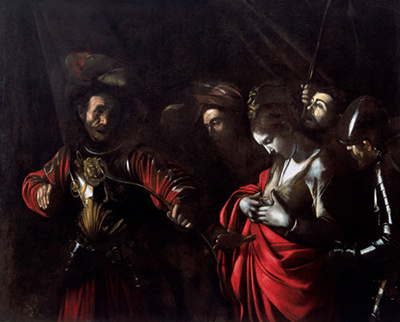Caravaggio completed The Martyrdom of Saint Ursula in 1610 and it is generally accepted as having been the very last painting of his career. This highly accomplished piece is the culmination of two decades of working at the very peak of Baroque art.
Marcantonio Doria was a young nobleman from Genoa who commissioned Caravaggio to produce this painting for him. The story around Saint Ursula was that her companions had been brutally murdered by the king of the Huns who offered to spare her in return for her hand in marriage. She refused and was punished as a result. Doria himself was already a keen follower of the artist and purchased any of his work that he was able to. The request for this commission was therefore nothing of a surprise to the artist and he gladly took on this task. The collector also recognised a growing desire for Caravaggio paintings and so was well placed to profit from his earlier loyalty to the artist. He would actually place the completed painting alongside a number of works from Raphael and Leonardo da Vinci, such was the impressive nature of his collection as well as the deep affection that he held for this exciting and innovative Baroque painter.
Caravaggio was known to have travelled around Italy many times, relocating frequently due to his own unstable behaviour. He arrived in Naples the year before this painting was constructed, having originally been in Sicily. Despite this being his second spell living in Naples, he was soon in trouble again and involved in fights inside and outside various drinking establishments. Much of his work produced around this point has not been conclusively attributed to him, but there is a much better confidence with this particular painting that all major publications on Caravaggio have accepted as being from his own hand. It is interesting to consider what more he might have achieved without the problems that he endured within his private life, but then without those behavioural characteristics, perhaps his artistic style would simply have been stale in comparison. The same can be said for many other troubled artists, but few have been as explosive as Caravaggio.
You will now find this impressive artwork in the the Gallery of Palazzo Zevallos Stigliano in Naples, Italy. The artist's work has become fairly widely dispersed between a selection of art galleries and private collections, though most still reside in Europe. That particular institution in Naples focuses entirely on Italian artists from the Renaissance and Baroque eras, with The Martyrdom of Saint Ursula remaining its biggest highlight. That besides, a trip to this venue should also bring some other notable artists to your attention, such as Angelo Caroselli and Bernardo Cavallino. There is also some work from Louis Finson who was a Flemish painter who produced a number of high quality copies of Caravaggio paintings during his career. Whilst this venue does not have quite the names of the more prominent Italian galleries, there is still much to enjoy here, particularly for those with a particular interest in the period of the Italian Baroque.




